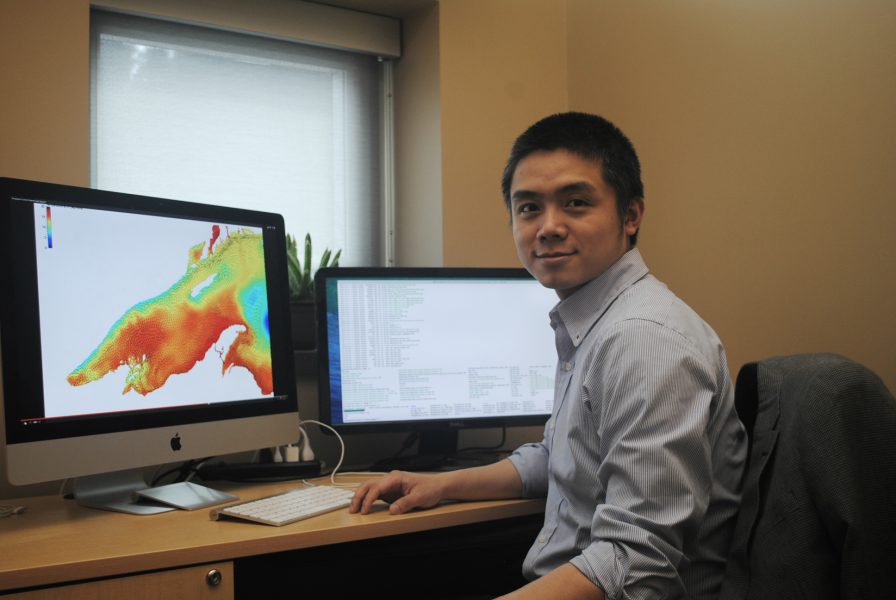
Pengfei Xue and Guy Meadows generously shared their knowledge on Husky Bites, a free, interactive Zoom webinar hosted by Dean Janet Callahan. Here’s the link to watch a recording of his session on YouTube. Get the full scoop, including a listing of all the (60+) sessions at mtu.edu/huskybites.
What are you doing for supper this Monday night 11/30 at 6 ET? Grab a bite with Dean Janet Callahan and Civil and Environmental Associate Professor Pengfei Xue, Director of the Numerical Geophysical Fluid Dynamics Lab at Michigan Tech’s Great Lakes Research Center.

Catch a glimpse of the future during his session, “Severe to Extreme: Modeling Climate Change and Coastal Hazards on the Great Lakes.”
The Great Lakes are more like inland seas. From the cold depths of Lake Superior fisheries to the shallow algae blooms of Lake Erie, the bodies of water differ greatly from one another. Yet they are all part of one climate system. Together they contain one-fifth of the world’s surface freshwater.
Xue uses mathematical modeling to analyze and predict the short-term and long-term responses of that system to climate stressors. During Husky Bites, he’ll introduce the regional earth-system model he uses to understand and predict how the Great Lakes system responds to weather extremes and coastal hazards.
Joining in as co-host for Husky Bites is Guy Meadows, who collaborates with Prof. Xue on the work.
We’ll get to see three modeled visualizations of the same storm passing by on Lake Superior. In each scenario, they’ll show and explain what could happen along the coast.
“The Great Lakes exert a strong influence on the physical, ecological, economic, and cultural environment in the region, across the nation, and internationally,” says Xue. “Human activities expose the system to multiple stressors. Climate change creates new risks and exacerbates existing vulnerabilities,” he adds.
“In my lab, we analyze and predict short-term events. We also project the long-term influence of climate change on the Great Lakes ecosystem. Our goal is to help inform decision-making and management. One of the important concepts in climate change, in addition to knowing the warming trend, is understanding that extreme events become more severe,” Xue says. “That is both a challenge and an important focus in regional climate modeling.”
It takes a supercomputer to run the calculations. Xue uses Superior, the supercomputer housed in the Great Lakes Research Center, to build high-fidelity models and detailed simulations for a region where more than 30 million people rely on the Great Lakes for water and other resources.
“I do the science part, but I also want to apply my findings.”
With his next generation numerical predictive models for the Great Lakes, Xue seeks answers to many “what-if” questions. “How will projected future climate change impact water levels, wave energy, sediment transport and shoreline damage?”
He also looks at short-term, episodic events like algal blooms and weather patterns.
His current research focuses on an Integrated Regional Earth System Model (IRESM, for short) for the Great Lakes region. The model consists of coupled atmosphere, lake, ice, wave, sediment, land surface, and biological components, and includes data assimilation and machine learning techniques.
The bottom line: Xue seeks to better understand the processes in the Great Lakes and their impact on people.

“We are extremely fortunate to have Professor Xue at Michigan Tech and the Great Lakes Research Center,” says Professor Guy Meadows. “He has built very strong bridges both within the University and with our government research partners. Thanks to these partnerships, we have modeling of the Great Lakes running on Superior at a resolution not previously thought possible.
Meadows joined Michigan Tech in June of 2012, to help establish the new GLRC. “This is a unique, amazing place. The future of Great Lakes research is based right here.”
A bit more about Pengfei Xue
Prof. Xue’s modeling research experiences in other regions include Massachusetts Coastal Waters, Gulf of Maine, East China Sea, the Maritime Continent in Southeast Asia, and the Persian Gulf.
Prof. Xue recently joined Argonne National Lab as a joint appointee Scientist in the Environmental Science Division. His joint appointment will expand the already deep capabilities of both institutions. Michigan Tech’s GLRC Director Andrew Barnard agrees. “Dr. Xue’s collaborative work with Argonne will result in cutting-edge science and engineering solutions in predictive hydrodynamics.”
Prof. Xue, when did you first get into engineering? What sparked your interest?
I liked math when I was a little kid. I was very much influenced by my father. He was a high-school physics teacher and would often pose math- or physics-related questions to challenge me for fun. Later when I was in college, I majored in mathematics and became very interested in how to apply math to helping answer some real-life questions. That’s how I got interested in numerical modeling and ended up what I am working on now.


Hometown, Hobbies, Family?
After finishing my doctoral study at UMASS-Dartmouth and post-doctoral work at MIT, I moved to Tech seven years ago. I live with my wife and two cute kids in Houghton. We enjoy spending time reading and playing together. You may see me up at Michigan Tech’s Student Development Complex working out or swimming, or out on the trails skiing—to relax and take my mind off work.
Read more:
Environmental Science Division of Argonne National Lab Welcomes Pengfei Xue
Weather the Storm: Improving Great Lakes Modeling
Guy Meadows: Shipwrecks and Underwater Robots
Where Modeling Meets Observations: Improving the Great Lakes Operational Forecast System
Video:

